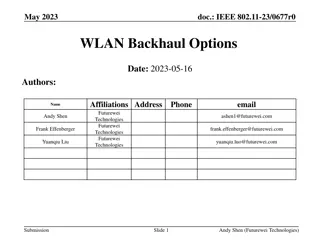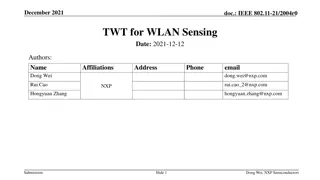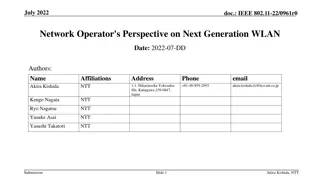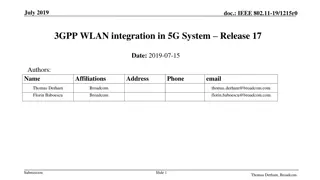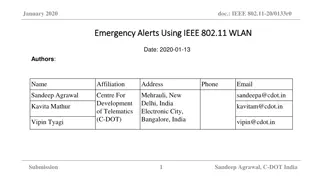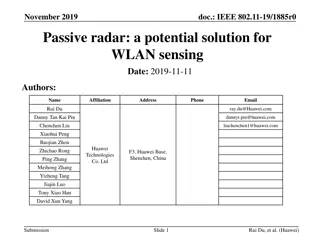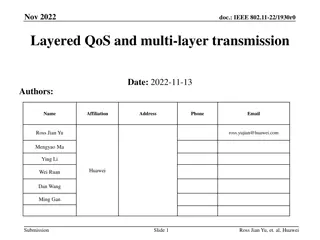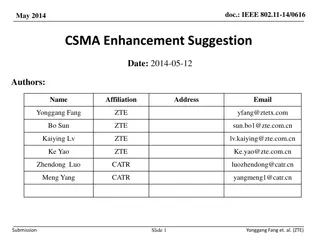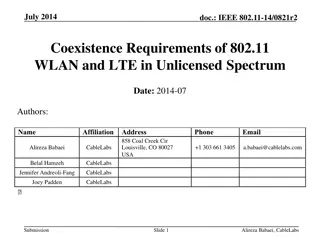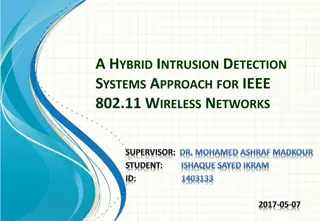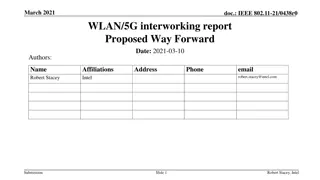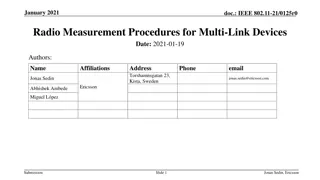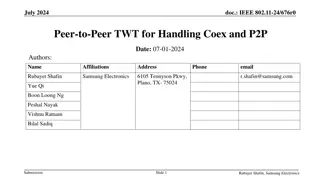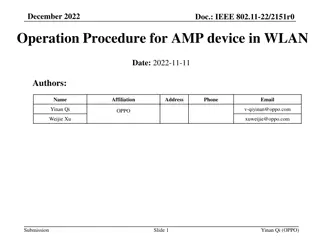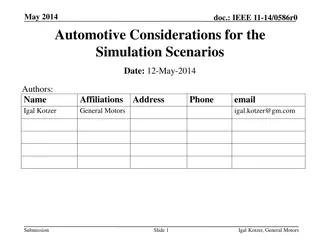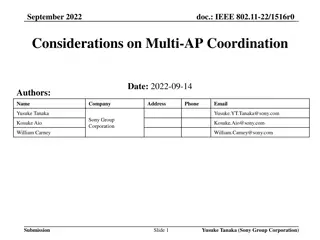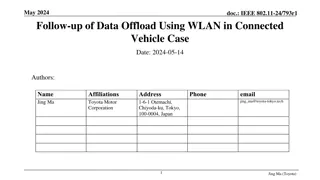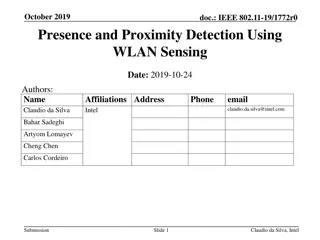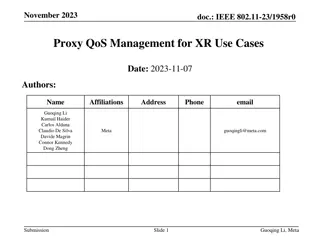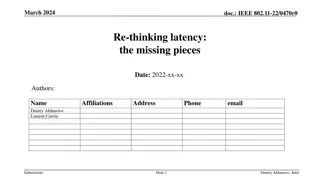Computer Peripherals and Interfacing
Computer peripherals are external devices that enhance the functionality of a computer. They include input devices like keyboards and mice, output devices like printers and monitors, and storage devices like hard disk drives and solid-state drives. Interfacing circuits connect these peripherals to t
1 views • 6 slides
High-Level Thoughts on Integrated mmWave Communication for WLAN Solutions
Market demands for WLAN solutions supporting high throughput and low latency applications have led to the development of Integrated mmWave (IMMW). This project focuses on integrating the mmwave band with sub-7GHz links to overcome range, mobility, and reliability challenges. IMMW aims to harmonize d
1 views • 7 slides
Understanding Network Devices and Connectivity
Network devices play a crucial role in connecting computers and printers to networks, facilitating fast and secure data transfer. These devices, such as network interface cards and WiFi cards, help devices communicate effectively on the same or different networks. MAC addresses uniquely identify dev
6 views • 31 slides
Japan MIC Frequency Realignment Action Plan - January 2024 Overview
The unofficial translation of selected contents from the Japan MIC's frequency realignment action plan details objectives related to IoT/WLAN, progress of unlicensed spectrum allocation, WRC-23 related updates, and plans for further advancement of WLAN, including bands utilization and technical cons
9 views • 6 slides
ML-Aided Channel Classification for WLAN Optimization
The paper discusses using machine learning to classify IEEE channel models and improve WLAN performance. It demonstrates how neural networks can accurately classify channel types, leading to efficient beamforming and signal processing. Simulation results show the classification performance even at l
0 views • 12 slides
Understanding Input and Output Devices in Computing
In computing, input and output devices play a crucial role in enabling communication between users and computers. Input devices are used to enter data into a computer, while output devices display or provide the results of processed information. Common input devices include keyboards, mice, and joys
0 views • 17 slides
WLAN Backhaul Options for Next-Generation Wi-Fi Networks
IEEE 802.11-23/0677r0 explores various backhaul options for WLAN, emphasizing Fiber to the Room (FTTR) technology based on Passive Optical Network (PON) for enhancing the performance of multi-AP coordinated next-gen Wi-Fi UHR. The document discusses wired and wireless backhaul connections, including
2 views • 15 slides
IEEE 802.11-21/2004r0 Target Wake Time (TWT) for WLAN Sensing
This technical document delves into the implementation of Target Wake Time (TWT) in wireless local area networks (WLAN) for efficient power management in sensing devices. It explores the significance of TWT in minimizing contention among stations, reducing power consumption, and optimizing wake sche
0 views • 14 slides
Discussion on WLAN Sensing Sequence Design in IEEE 802.11-20/1328r0
This presentation by Rui Du from Huawei discusses the design of sequences for WLAN sensing in IEEE 802.11 standards. It covers topics such as existing sequences, analysis of sequences, ambiguity functions, Golay sequences, and properties adopted for communication sequence design.
4 views • 14 slides
Automotive Grade 10 Joining Methods: Locking Devices Overview
Automotive Grade 10 explores joining methods using locking devices to prevent nuts from loosening due to movement and vibration. Friction-locking devices include lock nuts, stiff nuts, and special washers. Positive-locking devices tighten nuts securely with slotted nuts, crowned nuts, tab washers, a
1 views • 7 slides
Next Generation WLAN: Network Operator's Perspective
Discussion on the next generation WLAN direction from a network operator's viewpoint, focusing on the integration of Wi-Fi and 6G mobile wireless to enable various use cases. Emphasis on B2B applications, proposed use cases in WNG SC for the post-be era, Wi-Fi markets for B2B growth, and inclusion o
0 views • 11 slides
IEEE 802.11-21/1321r1 WLAN Sensing Procedure Proposal
This document by Solomon Trainin from Qualcomm presents a proposal on aligning the SFD for the WLAN sensing procedure. It aims to resolve contradictions, optimize behavior, and introduce a structured WLAN sensing procedure. The content outlines phases, terminology, setup, measurement, and reporting
0 views • 8 slides
Radar Function Integration in WLAN: January 2019 Discussion
The January 2019 document IEEE 802.11-19/0080r0 explores integrating radar functions into WLAN to enhance coexistence. The proposal outlines various options, including modified schemes and dedicated indication methods for radar operation within WLAN frameworks. It emphasizes the need for feedback on
3 views • 12 slides
IEEE 802.11-19/1215r0 WLAN Integration in 5G System Release 17 Overview
This document discusses the integration of WLAN access as another RAT in the 5G System architecture, emphasizing the progression from 3GPP Release 15 to Release 17. Key points include unified authentication frameworks, QoS provision in managed WLAN, traffic steering mechanisms, and the convergence o
0 views • 11 slides
Emergency Alerts Using IEEE 802.11 WLAN in India
Proposal for utilizing public Wi-Fi infrastructure in India for emergency communication, focusing on early alerts for natural and man-made disasters. Discusses the limitations of cellular communication and suggests using IEEE 802.11 WLAN technology to enhance communication in critical situations.
0 views • 14 slides
Passive Radar for WLAN Sensing in Indoor Scenarios
Radar and CSI have been proposed as potential WLAN sensing techniques. This document focuses on passive radar at 5 GHz in indoor scenarios, discussing background, experimental results, signal processing techniques, and potential impacts on WLAN standards.
6 views • 15 slides
Layered QoS and Multi-Layer Transmission in IEEE 802.11-22 for Enhanced WLAN Performance
The document discusses the importance of layered Quality of Service (QoS) and multi-layer transmission in meeting the high throughput and real-time requirements of metaverse applications over WLAN. It emphasizes the need for enhanced throughput, reliability, reduced latency, and improved power effic
0 views • 11 slides
Wireless LAN Sensing Use Cases in Home Environments
The document discusses use cases for Wireless LAN (WLAN) sensing in home environments, focusing on the connection between multiple access points and home appliances for enhanced performance. It outlines scenarios such as gesture-controlled home appliance operation, user identification for personaliz
0 views • 11 slides
Overview of Computer Input and Output Devices
Input devices of a computer system consist of external components like keyboard, mouse, light pen, joystick, scanner, microphone, and more, that provide information and instructions to the computer. On the other hand, output devices transfer information from the computer's CPU to the user through de
0 views • 11 slides
IEEE 802.11-21/0391r0: Minimizing Impact in WLAN Sensing Design
The document presents discussions on minimizing impact as a design goal within the IEEE 802.11-21/0391r0 context, emphasizing the efficiency related to the impact of sensing on network performance. It addresses the current status, constraints, design options, and thoughts regarding WLAN sensing with
1 views • 8 slides
Evaluation Metrics for IEEE 802.11-14/0107 HEW Proposal
Evaluation metrics play a crucial role in assessing WLAN system performance and achieving the objectives of High Efficiency WLAN (HEW). This proposal by Yonggang Fang et al. from ZTE outlines the key evaluation metrics recommended for evaluating HEW performance, including area throughput, average th
0 views • 12 slides
Enhancing CSMA/CA Efficiency in High-Density WLAN Deployment
CSMA/CA mechanism in IEEE 802.11 is efficient for low-density WLAN deployment but lacks effectiveness in high-density scenarios. This submission suggests improving spectrum efficiency by shifting contention in the code domain. The aim is to address the performance and user experience in dense deploy
1 views • 14 slides
IEEE 802.11-15/1064r0 Long Range, Low Power Design Criteria Study
Submission on design criteria for Long Range, Low Power (LRLP) in WLAN systems aiming to enhance transmission reliability and range while ensuring compatibility with existing WLAN networks. The key technical components include ultra-low power consumption, communication range extension, and coexisten
0 views • 8 slides
Coexistence Requirements of 802.11 WLAN and LTE in Unlicensed Spectrum
Presentation from July 2014 discussing the impact of LTE in unlicensed spectrum on 802.11 WLAN networks. Highlights proposals for TGax functional requirements document. Examines LTE-U and its challenges for coexistence with other technologies like Wi-Fi. Details LTE quiet periods and lab test condit
0 views • 12 slides
A Hybrid Intrusion Detection System Approach for IEEE 802.11 Wireless Networks
This research project explores the development of a hybrid intrusion detection system for IEEE 802.11 wireless networks. The study includes research objectives, background information, experimental results, evaluation, and comparison of existing systems, HWIDS design, conclusions, future work, and r
0 views • 73 slides
Proposed Way Forward for WLAN/5G Interworking Report
The document discusses objections to a technical report on WLAN/5G interworking within the IEEE 802.11 Working Group, highlighting inaccuracies and lack of detail. Rejected comments point out misunderstandings and shortcomings in defining interworking functionalities between WLAN and 5G as per 3GPP
0 views • 6 slides
IEEE 802.11-21/0125r0 Radio Measurement Procedures for Multi-Link Devices
The IEEE 802.11 WLAN standard introduces the concept of Multi-Link Devices (MLD) in the 802.11be (EHT) amendment, enabling multiple affiliated STAs to work together. This document focuses on enhancing radio measurement procedures for MLDs to boost efficiency and flexibility in managing radio resourc
0 views • 14 slides
Data Offload Using WLAN in Connected Vehicles
The document discusses the need for data offloading from cellular networks to WLAN in connected vehicles to address overwhelmed cellular capacity and reduce costs. It highlights the challenges and gaps in current standards like IEEE 802.11u, emphasizing the importance of Wi-Fi infrastructure for con
0 views • 10 slides
Data Offload Using WLAN in Connected Vehicles
The market for connected vehicles is rapidly growing, leading to increased data consumption. This document highlights the importance of offloading data from cellular networks to WLAN in connected vehicles. Current solutions like 802.11u are insufficient, necessitating new standards to address the ch
0 views • 10 slides
Enhancements for In-Device Coexistence in WLAN Devices
This document presents potential enhancements to IEEE 802.11 standards to improve in-device coexistence for WLAN devices. It addresses the challenges of coexistence events caused by interactions with other Wi-Fi and non-Wi-Fi devices, proposing solutions for handling these issues efficiently. The fo
0 views • 10 slides
Energy Harvesting Operation Procedures for AMP Devices in WLAN
This submission delves into the operation procedures of AMP devices in WLAN setups, focusing on energy harvesting techniques for various power sources like solar and RF. It details the operation procedures for devices with and without energy storage, highlighting configurations for day and night use
0 views • 8 slides
Proposing Dynamic CCA Control for Performance Optimization in WLAN
This presentation discusses the variability in dynamic CCA performance in WLANs and proposes a protocol control mechanism to maximize benefits and minimize drawbacks. It emphasizes the need for an effective control to navigate differing configurations and achieve system throughput improvements witho
0 views • 21 slides
Understanding I/O Systems and Devices
I/O systems and devices play a crucial role in computer operations. They can be categorized into block devices and character devices based on their functionalities. Block devices store information in fixed-size blocks with addresses, while character devices handle character streams. Some devices, li
0 views • 19 slides
Automotive Considerations for IEEE 11-14/0586r0 Simulation Scenarios
This document discusses the integration of automotive-related scenarios into IEEE 802.11ax simulation scenarios, focusing on the use of high-speed WLAN in vehicles, particularly during traffic jams. The characteristics, requirements, and challenges of establishing a data link in traffic congestion s
0 views • 11 slides
Analysis of WLAN Sensing Sequence Design Using Ambiguity Function and Range-Doppler Map
In this document, the authors from Huawei discuss the analysis of employing the ambiguity function for WLAN sensing sequence design. They delve into the ambiguity function's definition, analysis, and its comparison with the range-Doppler map. The document highlights the importance of ambiguity funct
0 views • 15 slides
IEEE 802.11-22/1516r0 AP Coordination Considerations
Review of discussions on AP coordination in WNG sessions and EHT SG/TGbe meetings, proposing advancements for future WLAN technology. Emphasis on the importance of prioritizing AP coordination to address various WLAN objectives effectively. Details on AP coordination subtypes and their impact on rel
0 views • 11 slides
Enhancing Data Offload Using WLAN for Connected Vehicles
Discussing the importance of data offload using WLAN in connected vehicles, highlighting the gap between current IEEE standards and the requirements for efficient data transfer. Emphasizing the need for fast association, seamless handover, and optimized algorithms for connected vehicle cases, with e
0 views • 11 slides
Presence and Proximity Detection Using WLAN Sensing
This document discusses the utilization of WLAN sensing for presence and proximity detection, focusing on identifying the presence of individuals, determining the number of people, monitoring well-being, and detecting human subjects in various environments. It explores use cases in smart home monito
0 views • 17 slides
Proxy QoS Management for XR Devices in IEEE 802.11-23/1958r0 - November 2023
This document discusses the challenges faced by XR devices in terms of size, thermal constraints, cost, and power limitations leading to the proposal of Proxy QoS Management to enhance Wi-Fi performance. The aim is to leverage TGbn devices for improving legacy devices' connectivity within a Wi-Fi ne
0 views • 6 slides
Re-thinking Latency Improvement in WLAN Connectivity
This document delves into the latency issues in WLAN transmission, focusing on channel occupancy and access problems that contribute to delays. It discusses the objectives of the UHR Study Group in enhancing WLAN reliability, reducing latencies, managing throughput, and minimizing power consumption.
0 views • 9 slides






